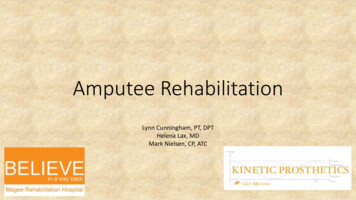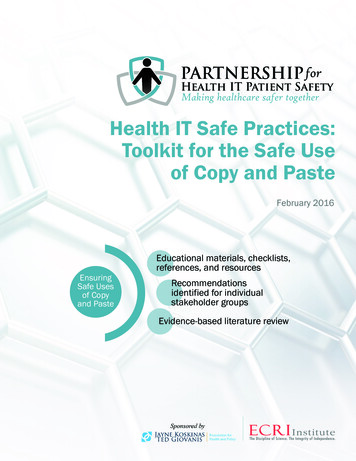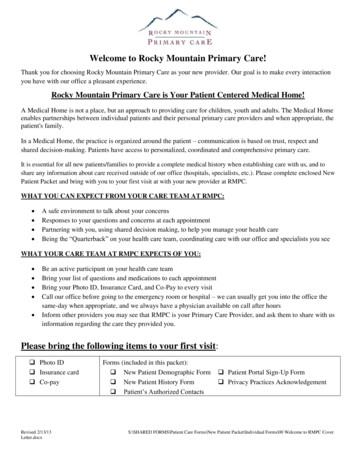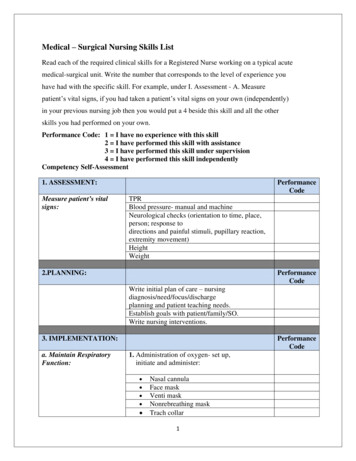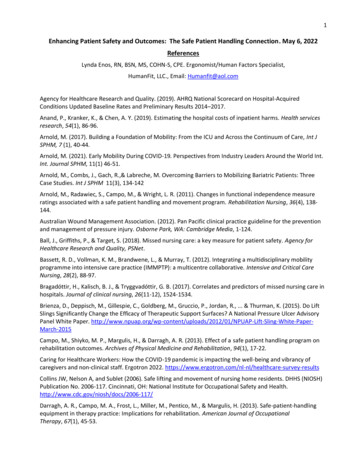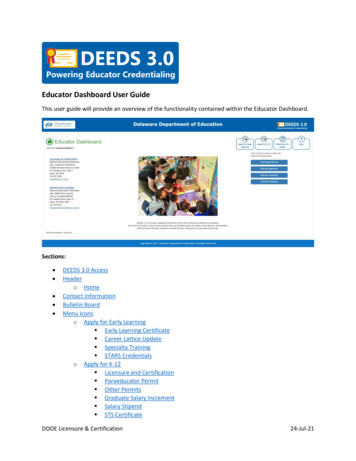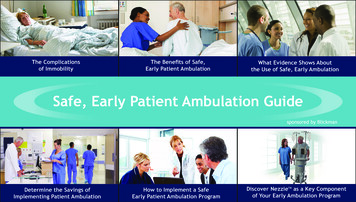
Transcription
The Complicationsof ImmobilityThe Benefits of Safe,Early Patient AmbulationWhat Evidence Shows Aboutthe Use of Safe, Early AmbulationSafe, Early Patient Ambulation Guidesponsored by BlickmanDetermine the Savings ofImplementing Patient AmbulationHow to Implement a SafeEarly Patient Ambulation ProgramDiscover NezzieTM as a Key Componentof Your Early Ambulation Program
The Complications of ImmobilityPost-surgical immobility can have various detrimental effects on a patient’s mind and body.The physiological effects may include ventilator-associated pneumonia, urinary tractinfections, bowel obstructions, deep vein thrombosis and pressure ulcers. In addition,immobility may contribute to various levels of depression. Preventing these complicationscan benefit the patient, caregiver and medical facility in terms of both costs and betteroutcomes. The links below provide further and related reading.sponsoredby BlickmanEvidence-Based PracticesImpact of early mobilization protocol on themedical-surgical inpatient population: anintegrated review of literatureEfficacy and safety of very earlymobilization within 24 h of stroke onset: arandomised controlled trialTemporal trends and risk factors forreadmission for infections, gastrointestinaland immobility complications after anincident hospitalisation for strokeKnowledge on complications ofimmobility among the immobilizedpatients in selected wards at selectedhospitalEffects of bedrest 1: cardiovascular,respiratory, and hematological systemsPrevalence and outcomes of low mobilityin hospitalized older patientsHospital management of older adultsDiagnosis-related group-adjusted hospitalcosts are higher in older medical patientswith lower functional statusFunctional decline in hospitalizedolder adultsMissed nursing care: view fromthe hospital bedAttitudes and expectations regardingexercise in the hospital of hospitalizedolder adults: a qualitative studyHome
The Benefits of Safe, Early Patient AmbulationNurses and Physical Therapists are aware of the benefits of early, safe, frequent patientambulation. The physiological benefits for the patient include improved functionalmobility, muscle strength, and a reduced duration of mechanical ventilation. Early, safe,frequent patient ambulation can also help avoid complications including urinary tractinfections, ventilator-associated pneumonia, bowel obstructions, pressure ulcers and deepvein thrombosis. Benefits for the hospital may include reducing costs via decreased lengthof Stay and reducing the incidence of hospital readmissions. The links below provide furtherand related reading.sponsoredby BlickmanEvidence-Based PracticesEarly mobilization in the intensive careunit: a systematic reviewTransforming the culture: the key tohardwiring early mobility and safepatient handlingSurgical intensive care unit mobility isincreased after institution of acomputerized mobility order setICU early mobilization: fromrecommendation to implementation atthree medical centersPostoperative ambulation in thoracicsurgery patients: standard versusmodern ambulation methodsMove to improve: the feasibility of usingan early mobility protocol to increaseambulation in the intensive andintermediate care settingsTransforming ICU culture tofacilitate early mobilityEarly postoperative ambulation:back to basicsWhat are the barriers to mobilizingintensive care patients?Active mobilization for mechanicallyventilated patients: a systematic reviewHome
What Evidence Shows Aboutthe Use of Safe, Early AmbulationAccording to Am J Crit Care. 2009;18(3):212-221, evidence indicates that patients inintensive care units have high morbidity and mortality, high costs of care and a markeddecline in functional status. Safe, early and frequent ambulation programs facilitated byPhysical Therapists and clinicians in the ICU can promote functional independence withoutany adverse reactions.sponsoredby BlickmanSuch programs can also help avoid common, secondary post-surgical complicationsincluding urinary tract infections, ventilator-associated pneumonia, bowel obstructions,pressure ulcers and deep vein thrombosis. Benefits for the hospital may include reducingcosts via decreased Length of Stay and reducing the incidence of hospital readmissions.Ongoing education and coordination with the inter-professional team as well as changes inprotocols, equipment, and ICU culture have been recommended to increase success.The links below provide further and related reading.Evidence-Based PracticesRespiratory weakness is associated withlimb weakness and delayedweaning in critical illnessEarly mobility and walking program forpatients in intensive care units: creating astandard of careEarly mobilization on continuous renalreplacement therapy is safe and mayimprove filter lifeVery early mobilization in stroke patientstreated with intravenous recombinant tissueplasminogen activatorSafety of out of bed activity and ambulationin patients with pulmonary artery cathetersEarly mobilization of LVADrecipients who require prolongedmechanical ventilationDoes ambulation immediately following anepisode of deep vein thrombosis increasethe risk of pulmonary embolism?The feasibility of early physical activity inintensive care unit patients: a prospectiveobservational one-center studyWhen can the patient with deep venousthrombosis begin to ambulate?Success of an early mobility program with apatient s/p mechanical ventilation withsevere axonal polyneuropathy in theintensive care unit: a case reportSafety of out of bed activity and ambulationin patients with pulmonary artery cathetersFeasibility of very early mobilization inIV-tPA treated stroke patients:a prospective studyFighting VAP one step at a time: earlymobility for the ventilated patientEarly mobilization of patients receivingextracorporeal membrane oxygenation: aretrospective cohort studyHome
Determine the Savings ofImplementing Patient AmbulationAccording to even the most conservative financial projections, the implementation of anEarly Mobility Rehabilitation Program for post-surgical and ICU patients can generate netsavings for U.S. hospitals. The investment will vary by hospital, but the return oninvestment is clearly positive relative to the improvements in patient outcomes, potentialreduced length of stay and the possible avoidance of secondary complications. The linksbelow provide further and related reading.sponsoredby BlickmanEvidence-Based PracticesWakeMed Cary Hospital “get up and move”early progressive mobilityICU early physical rehabilitation programs:financial modeling of cost savingsThe importance of early rehabilitationand mobility in the ICUEarly rehab in ICU generates net financialsavings for hospitalsICU early physical rehabilitation programs:financial modeling of cost savingsICU early physical rehabilitationprograms: financial modeling ofcost savingsEarly progressive mobility and othernurse-led initiatives yield positive patientoutcomes, financial savings atNorth Carolina hospitalsReduction of intensive care unit length ofstay: the case of early mobilizationImproving mobility to decrease thelength of stayEarly mobility in the ICUEarly mobility program for patients postacute ischemic stroke and acutehemorrhagic strokeEarly and progressive ambulation in theopen heart surgery patientsICU Early Physical Rehabilitation Programs:Financial Modeling of Cost Savings.Cost Analysis of Shock Wave LithotripsyDVT CostsDelirium CostsHome
How to Implement a SafeEarly Patient Ambulation ProgramIf we want to achieve substantive and sustainable improvements in patient outcomes, wehave to change the flawed components of the systems in which clinicians work. We mustredesign systems to consistently produce wellness instead of harm.Reference: Early Mobility Toolkitsponsoredby BlickmanThe success of a safe, early patient ambulation program is anchored in its development.Hospitals must establish the need and define the objectives of such a program, not only togain buy-in and give life to the program on an administrative level, but to ensure buy-in ona daily basis through all clinical levels to ensure the protocols are adhered to.Implementation involves communicating clearly defined objectives and establishingprotocol specifics to ensure the highest possible levels of adherence. The links belowprovide further and related reading.Evidence-Based PracticesEarly progressive mobility protocolImplementing a mobility assessmenttool for nursesEarly mobility and safe patient handlingA resource guide for implementing a safepatient handling program in theacute care settingKeep the beat, move your feetearly & progressive mobility forcardiac surgery patientsCritical care nurses’ role in implementingthe “ABCDE bundle” into practiceWalk this wayearly progressive mobility in the ICULet’s move It! early mobility protocolimplementation in a surgical ICU andacute care settingHome
Discover Nezzie as a Key Componentof your Early Ambulation ProgramDeveloped by a Thoracic Surgeon and available exclusivelythrough Blickman — Nezzie, is designed to be parked bedside,holds all devices, monitors, oxygen and IV poles, therebyeliminating the need to transfer and carry each item duringambulation. Nezzie reduces the number of clinicians needed;creating a better department workflow. Nezzie features asuperior design that holds more equipment than competitiveproducts, yet remains stable, enhancing patient and staff safety.Nezzie uses no more room than a standard IV pole.Nezzie is Designed to:It Matters:ClinicallyValidatedSafetyTestedFacilitate Frequent Patient AmbulationReduce Complications of ImmobilityImprove a Patient’s Sense of Independence and Well-BeingIncrease Patient and Staff SafetyIncrease Department Efficiency and WorkflowIncrease Staff SatisfactionReduce CostNezzie VideoNezzie on the Nurses ShowNezzie BrochureNezzie’s FeaturesNezzie Device Test ReportPrepared by: SGSDr. Nesbitt studyHomeRequest a Free DemoTech bulletin safety test resultsRequest a QuoteSavings Calculator
WakeMed Cary Hospital "get up and move" early progressive mobility Early rehab in ICU generates net financial savings for hospitals Early progressive mobility and other nurse-led initiatives yield positive patient outcomes, financial savings at North Carolina hospitals Early mobility in the ICU ICU Early Physical Rehabilitation Programs:
